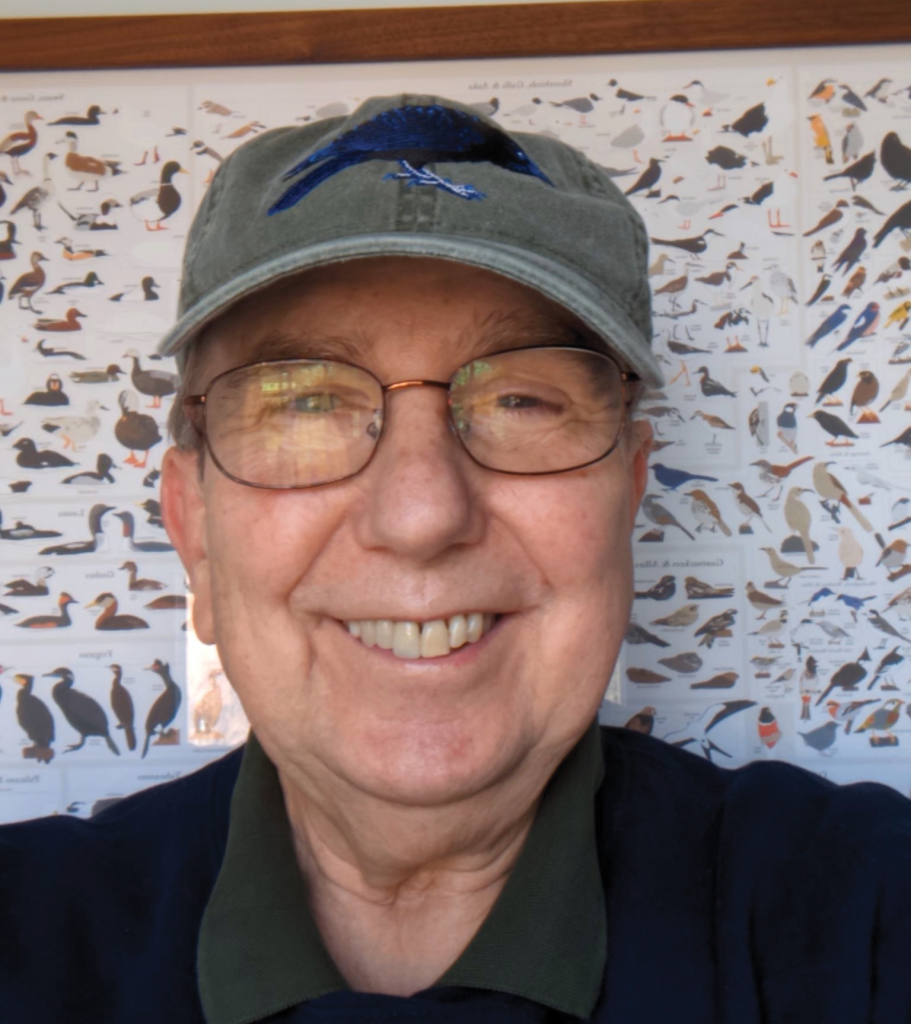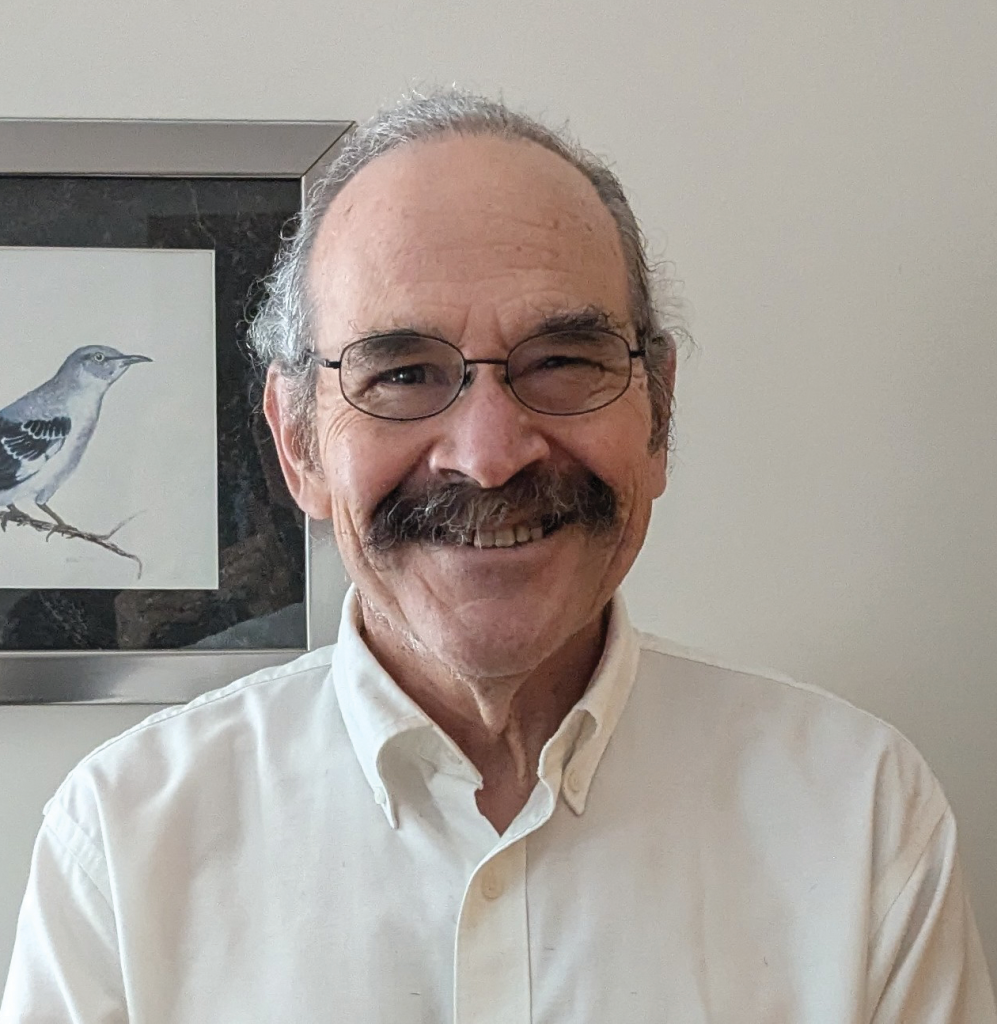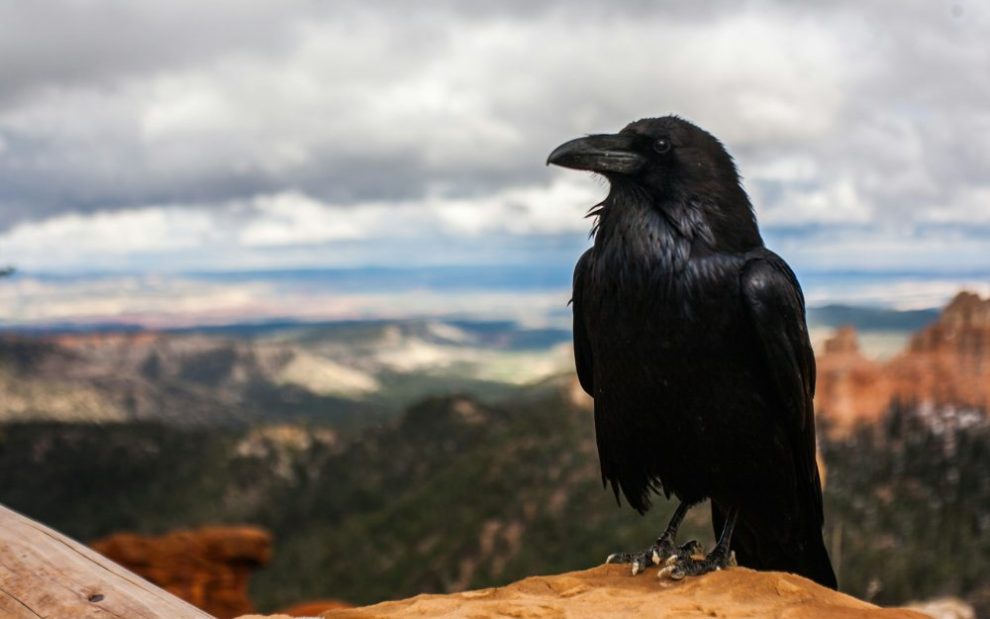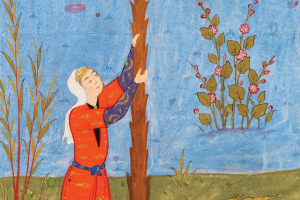
The idea of writing about birds in world religions started with an argument about turkeys. Petra Gardella and Laurence Krute, then both professors at Manhattanville University—Gardella in religion and Krute in anthropology—cotaught a class on Native American religions. “We were in class, and I happened to share a story I had heard about turkeys attacking cars and bikes in Brookline, Massachusetts,” Gardella says. “I thought a big turkey would come almost up to your chest, but Larry is a birder and said turkeys were much smaller. He ended up taking me birding in 2008, and that’s really when we began to talk about the significance of birds.”
Krute has his own story about what brought him to birds. “I did fieldwork in the Amazon rainforest, and the Amazon presents itself, first as sound,” he says. “Traveling along the river, you get very little visual detail, but you hear the birds right away. Because of this, the Indigenous languages in that area have lots and lots of words for different kinds of birds and different bird sounds. I brought that sense of significance back to the United States with me.”

Almost two decades later, those initial conversations resulted in Wings of the Gods (Oxford University Press), a new book cowritten by both Gardella and Krute. Including research on evolution, mythology, and spirituality, the book explores the deep relationship between birds and humans that has existed for millennia and argues for reclaiming this relationship in order to address our current ecological crisis and embrace a deeper reverence for all of creation.
What’s one story about birds in world religions that has really stuck with you?
Petra Gardella: I really love the Haudenosaunee creation story with Sky Woman falling from the sky. She gets kicked out of heaven because she’s pregnant and her husband suspects it’s by somebody else. So as she looks down out of a hole in the sky, he kicks her on the back, and she falls. She’s falling and falling, and our world is just water, but the water birds—the geese, the ducks, and the swans—see her falling. They catch her, set her down gently on the water, and hold her afloat with their wings and their bodies.
“What are we going to do?” the birds say. “She can’t live down here.” So the diver ducks try to dive down and get some land to put underneath her, but they can’t. Eventually a turtle comes along, and the birds recruit it to swim down and grab some land. The turtle comes up with some dirt on its back, and that’s where they put her. The land grows to become North America, what they call Turtle Island. I love this story and how it expresses so much about what these people felt about water birds and how helpful they are.
I also really love the story about Raven creating the world in Northwest Indigenous communities. They have this story about how an evil giant puts the sun in a box. Raven fools him into letting the sun back out of the box, marries his daughter in the process, and does all sorts of things.
At first, that story was crazy to me—how can you think a raven created the world? But when people came across Siberia into Alaska 12,000 years ago, after the last ice age ended, they followed ravens. Ravens led these hunter-gatherer groups, showing them where water was and what plants they could eat. It makes sense they would think Raven created the world, because ravens led them through the world. Ravens were there millions of years before humans were. In fact, birds actually planted the northern forests after the ice age ended. We wouldn’t have the forests there except for birds dumping their seeds. Birds participate in the creation of the world; they don’t just fly through it.
Laurence Krute: I actually have another version of the creation story that’s similar to the Haudenosaunee, or Iroquois, story. Together, as a genre, these are all called earth-diver stories. The Ainu Indigenous people of northern Japan have a story that, in the beginning, there were only thunder demons and kamuy, a wide variety of different kinds of spirits.
At some point, they are moved to create land, so they send a bird kamuy down to collect earth and put it on the back of a trout. That kamuy doesn’t really do a good job; it’s kind of sloppy and messy. So a duck called a wag tail or water wagtail comes along and says, “I can fix this up. I can do it better,” and taps down the earth with his feet, hits it with his tail, and firms it up so that the kamuy can come down themselves and live on the land. Eventually they also put people on the earth, and they all take refuge together from the thunder demons that rage through the storms.
What do these stories say about how ancient people felt about birds?
Gardella:I once wondered why birds are always in creation stories, and Larry pointed out that they mediate between the earth, sky, and sea. They’re the only living thing that does.
In the Book of Genesis, it says that the Spirit of God “brooded” over the deep. Very few people realize that the word is a very specific verb, m’rachefet, which means “hovered.” The only other instances of this word in scripture refer to a bird hovering over its nest—like in Deuteronomy where it talks about how God took care of Israel when Israel was in its nest. In other words, the God of Genesis 1:1 is like a bird, brooding over the waters and bringing forth the earth like a bird brings forth a chick from its egg.
Krute: Birds are a universal experience of humanity. They exist pretty much everywhere except maybe on the poles. They also act like us: They walk on two legs, have two arms, have families, build homes, take care of their young, and speak. They are like us, except they have a superpower: They can fly.
Are birds ever the antagonist of the story? Or are they always the hero?
Gardella:The Mayans tell a story that during the Mayan apocalypse there was a bird that tried to make itself king of the world. It tried to take its place on top of the World Tree and had to be killed by one of the hero twins in the Mayan story.
The only other example we could think of is in Hitchcock. Hitchcock was terrified of birds—have you seen the movie The Birds? If you think about it, seagulls and crows were the biggest birds in the movie: That’s because in 1962, there were no eagles and hawks around the United States. They were practically extinct—there were only a few hundred bald eagles left. If you made that movie now, it could be much more grisly. You could have eagles and Peregrine falcons tearing out people’s throats at 200 miles an hour. If these birds actually turned on us, I don’t think there’s very much we could do that wouldn’t also kill us. I mean, sure, we could obliterate life on Earth, but that wouldn’t do us much good.
Krute: There are lots of stories about trickster birds, but tricksters aren’t evil; they’re just oblivious. Sometimes they’re narcissists out for their own selves, but they’re not intentionally evil.
There are also birds like the vultures who consume the dead in India, or the vultures who tear at Prometheus’ liver. They’re not evil; they’re just performing their roles.
Gardella: The earliest funerals we know about are in Çatalhöyük, in modern-day Turkey, and it looks like they let vultures take their dead. They thought that burying or burning dead bodies polluted the world, and vultures were how to avoid that.
Kundun, the Martin Scorsese movie about the Dalai Lama, starts with his predecessor being chopped up and fed to the birds. All of the monks are laughing and happy, and the vultures are eating the former Dalai Lama. In Tibet, they even have a tradition where they grind down the bones and feed the resulting paste to smaller birds so that a person’s entire body is given to the spirits.
What’s so significant about birds? Why do birds show up so universally in global mythologies and not, say, large cats?
Krute: First, birds are a universal experience. Perhaps many cultures have experience with large cats, but they’re not as universal as birds. And second, like I said earlier, birds are a model of us. They look like us, they walk like us, they have arms, they talk, they have families, they build nests or houses. Some of them even build towns. Birds are accessible, and yet they have this additional ability that we would like to have.
Gardella: Birds may have taught humans about rituals. The Hopi believe that birds are the source of their language. In fact, we’re just discovering now how good birds’ language is—it’s amazing how many discoveries we’re making that people 10,000 years ago would have taken for granted.
For example, the pigeons and crows in your neighborhood know you personally. They know your face, and they’ll talk to one another in the backyard about anyone entering. Black-capped chickadees will often flock with other little birds, and they usually warn and protect the house sparrows and titmice and other birds they flock with. They say that if black-capped chickadees were as big as hawks, nobody could go outside.
What keeps us from having this sort of meaningful mythology with birds today?
Gardella: We’ve lost about 70 to 95 percent of the total bird population of the United States since 1492, and yet birds are still ubiquitous. It’s tragic to think about how where we see one or two birds, our great-grandparents saw two dozen birds, and Native Americans saw hundreds of birds in the same settings.
The Waso of Kenya, Romans, and Tibetans were able to talk about the future by marking off a square in the sky and analyzing the birds that flew through in certain directions. They got all kinds of messages about oncoming storms and things that were really happening in the world around them. But we couldn’t do that now: We’ve depopulated the birds to the point where there might be only one or two that come across in 15 minutes.
Birds are the best sign we have about the Earth’s overall health. If we were to focus our ecological efforts on making the world a good place for birds, it would also make it a good place for us. We need to help the world recover and make the world a place where birds can mass again.
Do birds have any kind of significance to modern-day humans?
Gardella: Bird watching is the most popular outdoor activity after gardening. Today, birds are the only wild animals most of us ever encounter. And we can have them as neighbors and pets without reducing their dignity or putting them in cages. People will say they fed the birds through the winter, but we don’t have to feed the birds through the winter; the birds will make it fine through the winter without us. We feed them because we like to look at them. We like to have them visit us.
When I was growing up, people thought that birds were just kind of mechanical and acted on instinct. They sang the same song all the time because somehow it was programmed into them. But even Mozart knew better than this; he had a pet starling that he credited with the beginning of his piano concerto in G major, because the starling changed one note and added a coda to something Mozart played.
Today, we know that all this amazing stuff is going on in the tiny brain of a magpie or crow. They can recognize all the people in the neighborhood, hold funerals. We’re discovering that bird songs are different in different places. If you go down the coast, you can tell what Carolina you’re in by how the birds are singing. They teach one another.
Krute: There’s a very large body of literature on the therapeutic effects of contact with birds. There are numerous individuals whose lives have been turned around because of their relationship with a specific bird.
How does all this relate to our faith? What is the meaning of birds in religion, for Catholics?
Gardella: From a Catholic standpoint, I hope that this book will keep us from thinking of birds as merely symbolic.
God, according to the Bible, took flesh in the form of a dove as well as a human. In the Gospel of John, there is an incarnation of the Holy Spirit as a dove on Jesus’ shoulder. It’s not just people who are incarnations of God; birds are a direct presence of divine power in the world.
Part of the thesis of our book is that there is in fact a religion of birds that has grown up since the days of John James Audubon. I used to hate Audubon’s art; I thought it was dead. He killed every bird he painted and strung them up on racks. It took him two weeks to paint his golden eagle, during which time people complained in the Boston hotel where he was working because it stank so badly.
But, as Robert Penn Warren writes, Audubon paints his birds as icons. They’re perfect, they’re full size, and they’re rendered in great detail. Their eyes, Warren says, are clear and, if they have any compassion, it’s not for us. They have a divine gaze. If we look at his art in this way, we can see birds as really direct experiences of the holy.
His work started this religion of birds that is reflected in the work of poets such as Emily Dickinson and Mary Oliver. And it’s still present today. The most popular Catholic hymn is “On Eagle’s Wings.” And this is a good thing: Too many religions have alienated us from the Earth or have this mindset that God set us here and then left. That attitude is going to kill us; we need to focus on the fact that we live in a sacred world.
Is there a story about birds that especially reminds you of the sacredness of all creation?
Gardella: The albatross doesn’t land for six years after it’s born. It takes off when it hatches and doesn’t step on land again until it’s ready to mate. It soars for years 10,000 feet above the Earth. It has glands that can drink seawater.
What consciousness there must be in something like that. It’s hard to imagine. We don’t know how long they live or how long they stay fertile. Scientists are watching this albatross who’s 75 years old and still laying eggs. The guy who banded her in the early 1950s died a few years ago in his mid-90s; he said that she hadn’t changed since he banded her when he was a 20-year-old student.
But we are doing terrible things to this incredible species. They’re amazingly resilient; they’re still there. But some of them are full of cigarette lighters. Some have died from eating the plastics we put in the ocean. They are suffering for our sins, just as Christ did.
What keeps us from recognizing the true significance of birds?
Krute: The inability to see birds as actors or agents is an outcome of our separation from nature. There are estimates that people in cities spend 95 percent of their time on artificial surfaces. Now, cities are living ecosystems in all kinds of ways, from Central Park to your shower head. And there are still birds around. But nevertheless, there’s a distance between us now.
Gardella:I think we are learning more from birds as time goes on. Even Audubon, although he had to kill the birds, saw God in birds all the time. He had no choice but to kill the birds to render them; he didn’t have cameras that could see things from thousands of yards away.
But we should practice seeing the world the way birds see it far more often. Maybe if we saw the ocean from the standpoint of the albatross landing on it, we’d see all the stuff we put in it and mobilize to clean it up. There are birds that migrate from pole to pole. If we really take this in, we realize that we have to figure out a global, coordinated way to take care of the world.
Does our relationship with birds—or any part of nature—play into how we think about social justice issues?
Krute: In 2020, Christian Cooper was in Central Park birdwatching and warned a woman that she needed to leash her dog in order to protect the wildlife. The woman called the police, falsely claiming that an African American man was threatening her and her dog. In this case, it’s not necessarily the act of birdwatching itself, but there’s this idea that an African American shouldn’t be standing in that place doing what they are doing. There’s this idea that they should be confined to specific places or activities.
Today, Cooper has developed a TV series where he explores various sites around the Western hemisphere where African Americans and other minority groups—Indigenous groups, rural people, etc.—are deeply involved with birds.
This goes back to what Petra was talking about earlier—you have to get everybody involved if you want any sort of change. Conservation has to really be a global movement.
Gardella: Politics and religion aren’t separable—church and state, yes, but not politics and religion. They both deal with basic questions of life and death, morality, values, who you’re going to punish for doing what, etc.
Audubon enslaved people. He took Mexican people’s bones from the Alamo when he was there because he was interested in phrenology. The New York City Audubon Society has changed its name—as have many of the societies around the world. He did many sinful things.
And yet, Audubon may have been Black himself. His portrait was on the walls of the New Orleans African American Museum and he was in several editions of the national Encyclopedia of Black Americans up to the 1980s. His complexion is described as brown on his 1836 passport. His father was a French sea captain who had wives and children in Haiti and New Orleans. There’s some dispute whether Audubon was born in one place or the other.
You can’t talk about politics without talking about religion, because it’s all a question of your ultimate values.
What’s one thing you want readers to take away from your book?
Gardella: A sense of wonder. That’s why I wanted the epilogue to be about the albatross: I wanted to give people a sense of just how much more there is in the world than human beings normally think about.
There is a world independent of humans, and that is wonderful. It’s a world that’s far larger than our bodies, and we need to appreciate it.
Krute: All of the above. But also, I came across this phrase that seems fitting: “In all of these kinds of efforts and all of these endeavors, there are no observers. There are only participants.”
This article also appears in the February 2025 issue of U.S. Catholic (Vol. 90, No. 2, pages 16-21). Click here to subscribe to the magazine.
Image: Unsplash/Tyler Quiring












Add comment